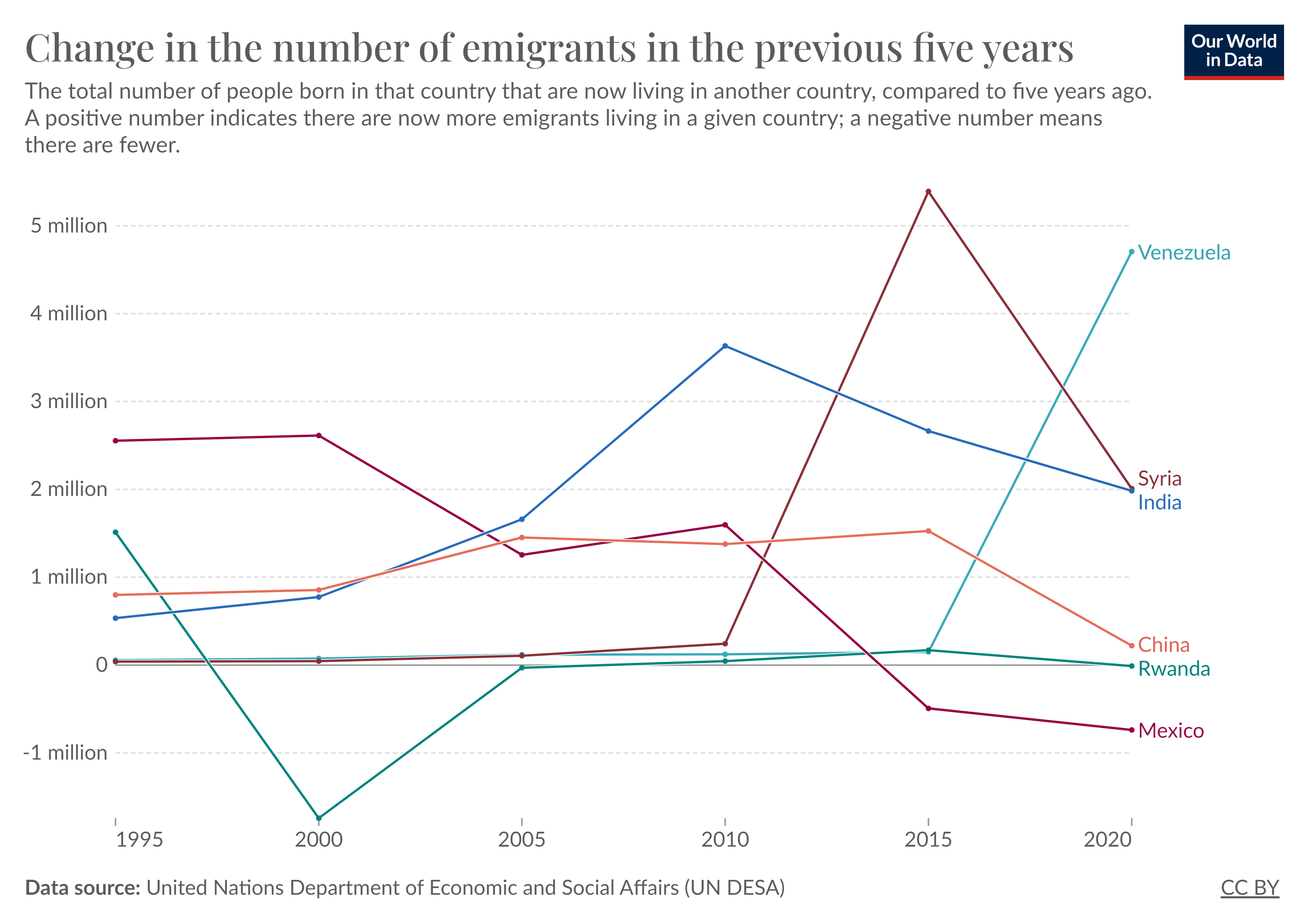
Every five years, the United Nations Population Division publishes datasets estimating international migrant numbers.
The three countries with the largest emigrant population increases in each five-year period since the UN began records are below, with emigrant population increase in brackets (in millions):
1990-1995: Mexico (2.6 m), Rwanda (1.5 m), China (0.8 m)
1995-2000: Mexico (2.6 m), China (0.9 m), India (0.8 m)
2000-2005: India (1.6 m), China (1.5 mil), Mexico (1.3 m)
2005-2010: India (3.6 m), Mexico (1.6 m), China (1.4 m)
2010-2015: Syria (5.4 m), India (2.7 m), China (1.5 m)
2015-2020: Venezuela (4.7 m), Syria (2 m), India (2 m)

Which country will have the largest increase in its emigrant population between 2020 and 2025, according to UN data?
Feel free to add other countries.
The UN data for emigration can be downloaded from their webpage, see [Total, origin] under the header Data. To obtain the five-year difference, one will need to manipulate the data by deducting the more recent year (e.g. 2020) from the previous year (e.g. 2015) for each entry in the tab named Table 1. For example, this is the top 20 countries by 5-year change after I manipulated the data in this way and sorted by largest 5-year change between 2015-2020:
See Our World In Data for the data in a user-friendly form.
Cool market, I have boosted it because I want more traders!
Two things to clarify for my benefit:
is it total emigration or net emigration?
if 5m Ukrainians move to Russia and 5m Russians move to Ukraine, will this be +0 or +5m for both?
if all of the people moving are Russian origin, would it be +0 for Russia and +5m for Ukraine?
More concisely, do migrants count as -1? Do returning emigrants count as -1?
is it the largest increase in real terms? Or percentage
if one country goes from 1m to 2m, is that a “larger increase” for this market than another going from 500k to 1.4m?
@Gen Short answer: (1) Net, but only with respect to nationals (non-nationals don't count), and (2) real terms/total, not percentage.
Long answer:
(1) As I understand this UN data product, they count every national who resides outside their country of origin (expats) to establish an emigrant population number (e.g. think about all the American citizens living abroad, added up). To resolve this question, I would take the 2020 emigrant population and deduct it form the 2025 emigrant population to get an increase (or decrease) in nationals living abroad. So if 5 million Ukrainians left Ukraine (to Russia, or anywhere), and 0 Ukrainians moved back to Ukraine, Ukraine's emigrant population would be +5 million (regardless of how many Russians moved to Ukraine, since Russian emigration would count towards the Russian emigrant population). If 5 million Ukrainians left Ukraine, but also, 5 million returned, then the emigrant population total would be the same in 2020 and 2025, and therefore the difference would be zero.
(2) Real terms/total, not percentage. So if everyone from a lightly populated country (e.g. a small island nation) were to be evacuated, this proportionally large exodus would be unlikely to outdo the absolute exoduses from other more populous countries (though Syria, Venezuela, Rwanda, and other countries with larger exoduses in the past have not necessarily had especially large populations). So in the 2015-2020 period, Venezuela had the largest total increase in their emigrant population (~4.7 million more people outside of Venezuela between 2015-2020). For the purposes of the "largest exodus," this question had been asked about 2015-2020 numbers, Venezuela would have resolved YES.